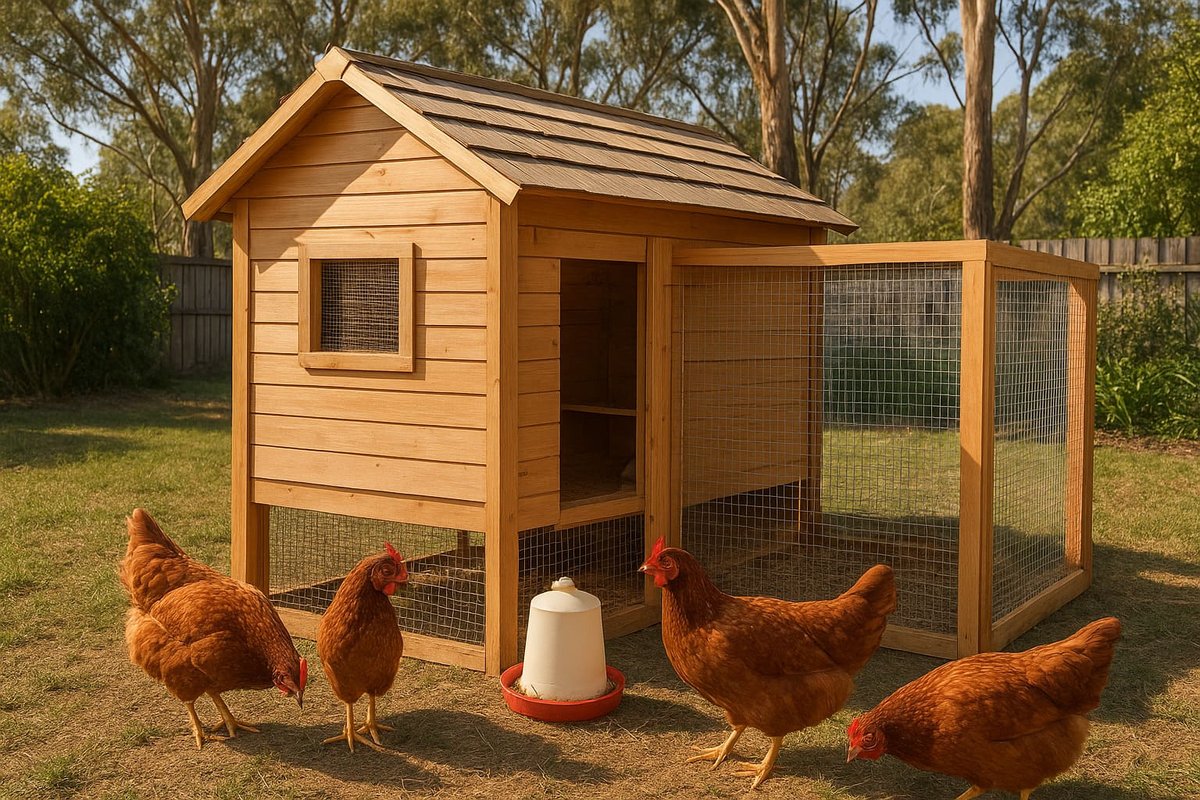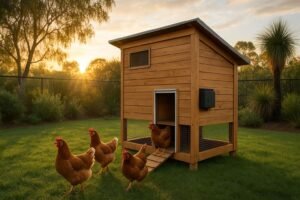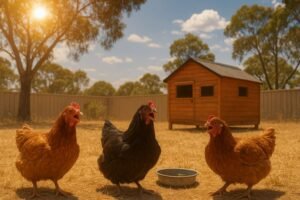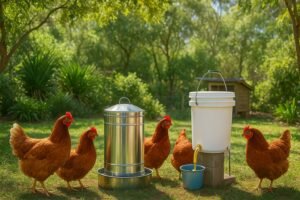So, you’re thinking about getting chickens? Good on ya! But before you dream of collecting those fresh, golden-yolked eggs every morning, you’re probably asking the big question: how much does it cost to start with chickens in Australia? It’s a great question to ask, especially with supermarket egg prices hitting an average of $7.13 a dozen (as of mid-2024) (and soaring up to $9.20 in some places!). Prices have only continued to rise into 2025. Plus, with recent avian influenza outbreaks in Victoria affecting egg supplies, it’s no wonder more Aussies are looking to their own backyards for a bit of food security.
Here’s the quick answer: Starting with 4 chickens in Australia can cost anywhere from $544 to $1,566 for the initial setup. After that, you’re looking at about $425 – $620 per year in ongoing, or “running,” costs.
This isn’t just another list. After keeping backyard chickens for over three years in regional Victoria, I’ve made all the beginner mistakes so you don’t have to. I’ve tried the budget setups and the premium gear, and I know what’s worth your money and what’s a waste. By the end of this guide, you’ll know the exact costs for a budget, average, and premium setup, and you’ll be able to confidently plan for your first flock. This is perfect for Australian beginners ready to get started.
Quick Cost Summary (4-Hen Setup)
- Budget Setup (Initial): $544 – $576 (4 hens, basic safe coop)
- Average Setup (Initial): $735 – $1,017 (better quality coop & gear)
- Premium Setup (Initial): $1,566+ (automated doors, large coops)
- Annual Ongoing Costs: $425 – $620 / year
- Monthly Ongoing Costs: $35 – $52 / month
- Payback Period: 2-3 years (if your family eats 2+ dozen eggs/week)
Now, let’s break that down.
Understanding the Real Costs of Backyard Chickens in Australia
When you start pricing things out, you’ll see costs vary wildly. Why? Because you’re in control of the biggest expenses. The main cost factors are:
- Your Setup: A DIY coop from recycled materials can be almost free. A premium, pre-made coop with solar-powered doors can cost over $2,000.
- Your Location: Council permits (if any) and the availability of feed and bedding in your area (metro vs. rural) will change your costs.
- Your Hens: Are you buying $14 day-old chicks or $38.50 point-of-lay hens that are already laying?
In my experience, the biggest cost surprise isn’t the setup; it’s the ongoing expenses. It’s easy to budget for the coop, but the cost of feed bags and bedding adds up over the year. The second surprise? Vet bills. A sick chook can cost $150 – $300 at an avian vet, which is often more than the cost of the bird itself.
But here’s the good news. The recent egg shortages in Victoria, which experts warn could persist until 2027, have driven huge interest in backyard flocks. While availability had improved slightly by late 2025 since the mid-2024 crisis, the supply chain remains fragile. This makes the return on investment for your own flock better than ever.
Important 2025-2026 Regulatory Changes for Australian Chicken Keepers
This is critical if you’re setting up in 2025-2026. You need to know about Australia’s new national poultry welfare standards being rolled out across states. These rules are based on the Australian Government’s national poultry welfare standards and apply to backyard keepers (under 50 birds), not just commercial farms.
- Victoria (from early 2026): According to Agriculture Victoria’s updated 2026 requirements, all new chicken housing must provide perches/platforms, scratch areas, nest areas (a minimum of 1 per 7 birds), and substrate (like straw or wood shavings) for pecking and foraging. Lighting requirements also now mandate a minimum of 6 hours of darkness per 24-hour period.
- Western Australia (from July 2025): As part of WA’s pioneering poultry welfare regulations, WA was the first state to ban the installation of new battery cages. For backyard setups, all housing must allow birds to perch, scratch, and nest naturally.
What this means for your setup costs: Budget an extra $30 – $80 for proper perches and nesting boxes if your chosen coop doesn’t include them. Most quality pre-made coops from brands like Somerzby already meet these standards, but be wary of cheap, flat-pack coops online, as they may not be compliant.
How Much Do Chickens Cost in Australia? (By Age and Breed)
First, you need the chooks! The price depends entirely on their age and breed. While hybrids like ISA Browns are popular, you might also consider heritage breeds like Australorp chickens, which are great layers too.
| Chicken Age | Common Breeds (ISA/Hy-Line) | Heritage Breeds (e.g., Sussex) | Vaccinated? | Ready to Lay? |
|---|---|---|---|---|
| Day-old chicks | $14.50 – $16.50 | $20 – $50+ | Usually | No (18-24 wks) |
| Pullets (12-16 wks) | $25 – $35 | $30 – $60 | Varies | No (6-12 wks) |
| Point-of-lay (18-20 wks) | $32 – $40 | $50 – $100+ | Usually | Immediately |
| Rescued Hens (2+ yrs) | ~$15 – $20 | N/A | Yes | Yes (declining) |
When choosing, it’s also worth considering heat-tolerant breeds suited to Australian summers to ensure your flock stays healthy and productive.
How Much Do ISA Brown Chickens Cost?
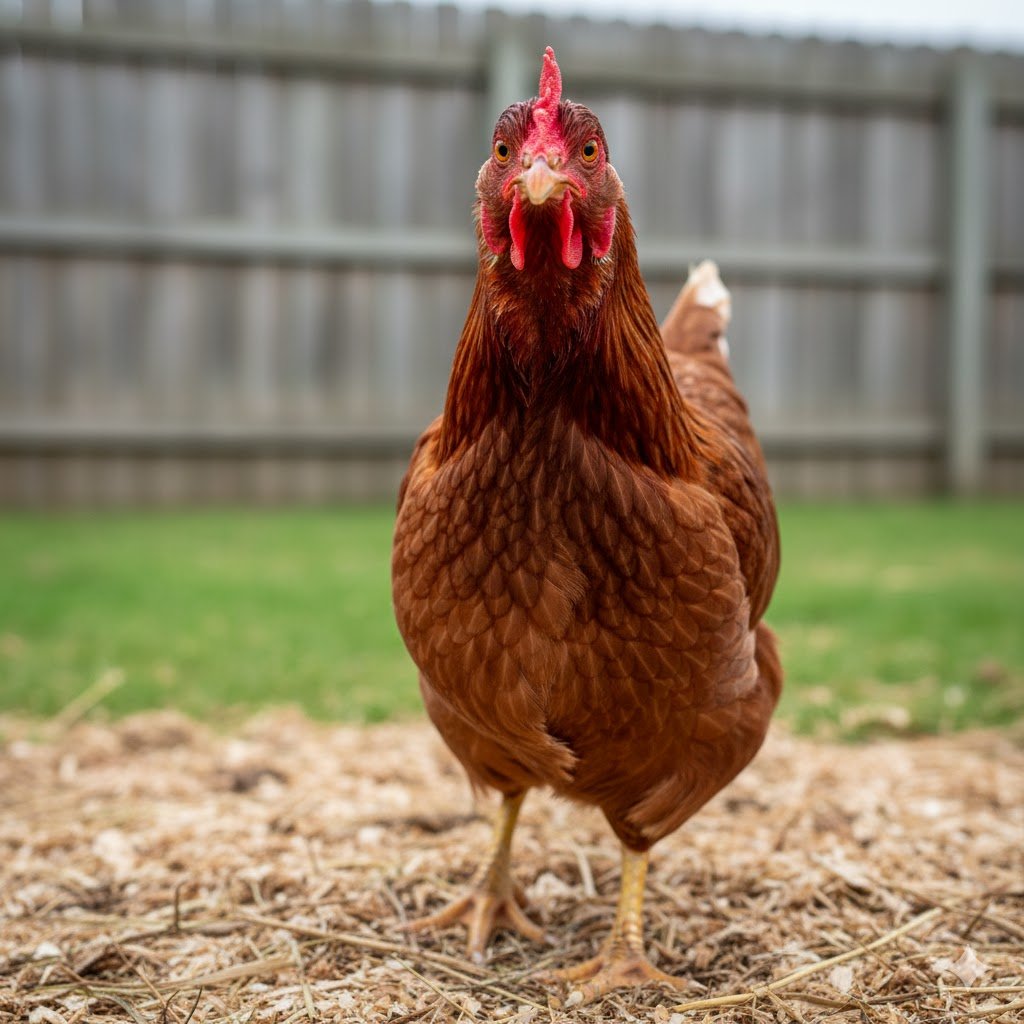
You’ll see ISA Browns (and similar Hy-Line Browns) advertised everywhere. According to commercial hatchery specifications, they are absolute laying machines, popping out 330+ eggs in their first year. They’ve been bred to be friendly and efficient. Because they’re so common, their price is consistent. Expect to pay around $14.50 for a day-old chick. Point-of-lay ISA Browns range from $32 to $40 depending on the supplier. For example, Heritage Hatchery in Queensland often prices them at $32, while many Victorian suppliers charge closer to $38-$40. This makes them one of the most popular and affordable options for getting eggs, fast.
Hy-Line Brown vs. ISA Brown: Price and Performance
Honestly, for a backyard keeper, they are virtually identical. Both are “hybrid” layers bred for high egg production and friendly temperaments. Their price is the same, and their laying is comparable. They are widely considered two of the easiest chicken breeds for beginners. Don’t stress this choice—just buy whichever is available from your local, reputable supplier.
Should You Buy Chicks, Pullets, or Point-of-Lay Hens?
For a full breakdown, check out our guide on deciding between chicks and adult hens.
- Point-of-Lay (POL): For 99% of beginners, buy point-of-lay hens. Yes, they cost the most upfront, but you get eggs immediately. You skip the 5-6 months of feeding and the hassle of “brooding” chicks.
- Day-old Chicks: I started with day-old chicks thinking I’d save money. The chicks cost me $15 each, but the brooder setup (heat lamp, special feed, brooder box) cost **$150**, and I still had to feed them for 5 months before I got a single egg. It’s a fun experience, but it’s not cheaper unless you already have the gear.
- Local vs. Mail-Order: You might see chicks for sale online that can be mailed. This is usually for bulk orders (50-100+ chicks) and isn’t practical for backyard keepers. Always buy from a local breeder, agricultural supply store, or a reputable hatchery you can drive to.
Where to Buy: Breeder vs. Feed Store vs. Gumtree
- Reputable Breeders/Hatcheries: (e.g., Heritage Hatchery, local poultry club members). This is the best option. The birds are healthy, vaccinated, and you get good advice.
- Feed Stores/Agricultural Supplies: (e.g., CRT, Elders). A great, safe option. They source from good hatcheries, and the birds are almost always vaccinated and at point-of-lay.
- Gumtree/Marketplace: High risk for beginners. You might get a bargain, but you also might be buying someone else’s problem—an old hen, a sick bird, or an unsexed “hen” that starts crowing at 5 AM. Avoid this for your first flock.
Buying the birds is the first step, but now you need somewhere to keep them.
How Much is a Chicken Coop? (Australian Options and Prices)
Your coop is your single biggest startup cost. It’s a predator-proof, weather-proof home for your hens. When looking, prioritise coops designed for Australian heat to ensure good ventilation.
Pre-Made Chicken Coops: Complete Price Breakdown
A safe, basic pre-made coop will start at $249+. Be very careful with online coops: many under $200 are made of thin, cheap fir wood and will rarely last more than 18 months in the harsh Australian weather. When buying, it’s important to calculate the right coop size for your flock to avoid overcrowding.
| Coop Size | Price Range (AUD) | Good For |
|---|---|---|
| Small (2-3 hens) | $249 – $369 | Beginners with small yards |
| Medium (4-6 hens) | $300 – $550 | The average backyard flock |
| Large (8-12 hens) | $600 – $1,700+ | Larger flocks, serious hobbyists |
Brands like Somerzby or My Chicken Coop are popular online options, but also check out specific snake-proof coop designs for Australia for extra security.
DIY Chicken Coop Costs in Australia
This is where you can save big bucks.
- Recycled Materials: Using old pallets, fence palings, and corrugated iron, you could build a coop for $0 – $100 (cost of screws and hinges).
- New Materials (Bunnings build): Building a sturdy coop from new timber and mesh will cost $250 – $500. It’ll be stronger than a pre-made one for the same price. You can even build a budget coop for under $200 if you’re handy.
What Makes a Good Australian Chicken Coop? (Predator-Proofing)
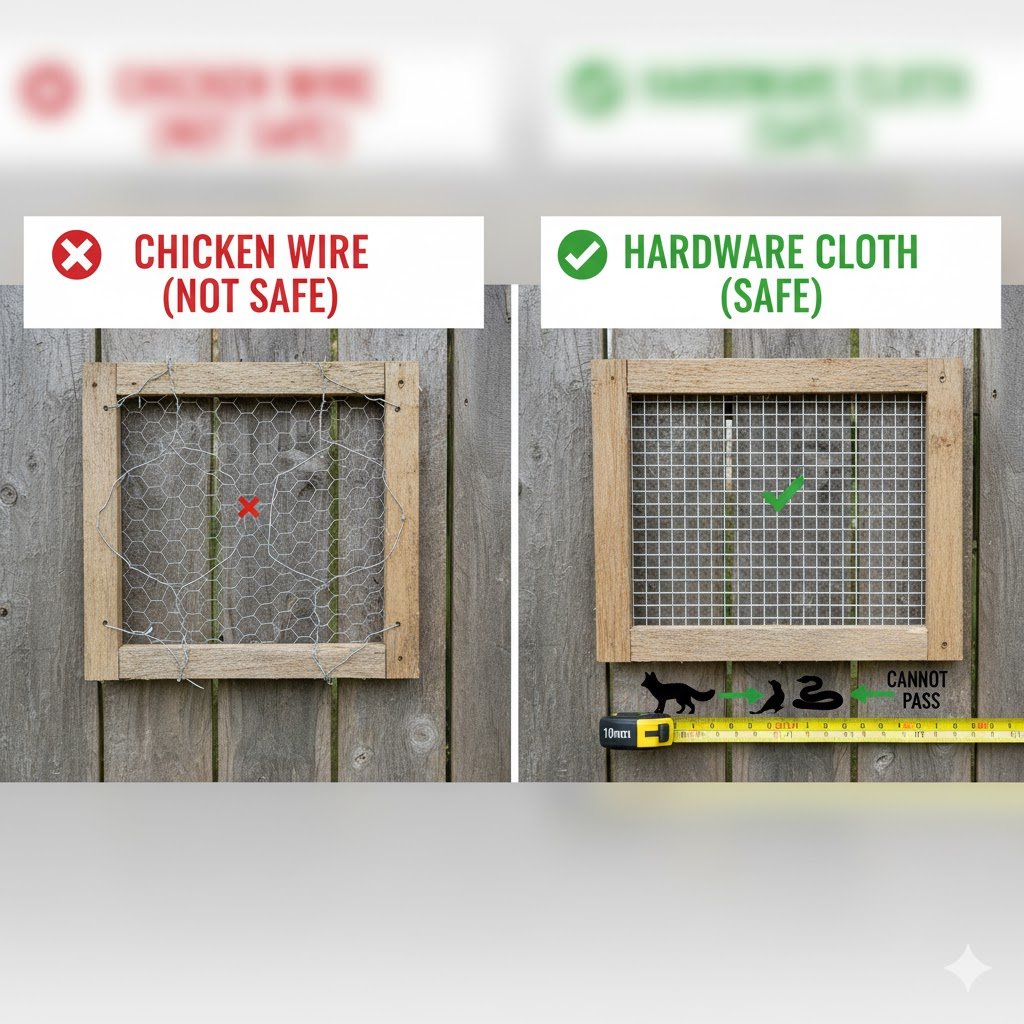
Your coop has one main job: keep your chickens in and predators out. In Australia, our top predators are foxes, snakes (pythons/browns), goannas, and quolls. For a full breakdown, read our guide to protecting your flock from foxes, snakes, and goannas.
- Solid Frame & Latches: Foxes are smart. They can flip simple latches. Use barrel bolts or latches with a carabiner.
- Hardware Cloth, NOT Chicken Wire: This is the most important rule. “Chicken wire” (the thin, hexagonal wire) only keeps chickens in. It does NOT keep predators out. A fox can rip it, and a quoll or goanna can tear right through it. You MUST use welded galvanised mesh, often called “hardware cloth.”
- Snake & Rat Proofing: Use hardware cloth with 10mm x 10mm squares or smaller. A 12mm mesh will stop a rat, but a small snake can still get through. 10mm is the safest bet. Our detailed snake-proofing guide shows you how.
- Dig-Proof Floor/Skirt: Foxes dig. Your coop must have a solid floor OR a mesh “skirt” extending 50cm out from the base, pegged firmly to the ground.
- Biosecurity (Wild Birds): Especially in states like Queensland where avian flu hasn’t struck, biosecurity is vital. Ensure your run is covered with mesh or netting to stop wild birds (like pigeons and magpies) from stealing feed and dropping diseases.
Another key part of coop design is managing our hot climate. Make sure you have a plan for keeping chickens cool during Australian summers.
Now you have the hens and the coop, let’s look at the gear to go inside.
Complete First-Year Setup Costs: Budget to Premium
Alright, let’s put it all together. Here are three sample budgets for starting with 4 point-of-lay ISA Brown hens, which is the most common beginner setup.
The “Bare Bones” Budget Setup: $544 – $576
This is the absolute minimum to get started safely.
| Item | Cost (AUD) | Details |
|---|---|---|
| 4 Point-of-lay ISA Browns | $128 – $160 | $32-40 each |
| Basic Pre-made Coop | $249 | 4-6 bird capacity (online). Meets 2026 welfare standards. |
| Feeder | $15 | Basic plastic model |
| Drinker | $15 | 4L plastic capacity |
| Bedding (Initial Bag) | $35 | Hemp or pine shavings |
| Basic First-Aid | $50 | Wormer, electrolytes, lice powder. See our chicken first-aid kit guide. |
| Feed (First Month) | $40 | 20kg bag of layer pellets |
| Nesting Material | $12 | Bag of straw or wood wool |
| Total Initial Cost | **$544 – $576** |
The “Average Aussie” Setup: $735 – $1,017
This is what I recommend. You spend a bit more on quality gear that lasts longer and saves you time.
| Item | Cost (AUD) | Details |
|---|---|---|
| 4 Point-of-lay ISA Browns | $128 – $160 | $32-40 each |
| Medium Pre-made Coop | $300 – $550 | Better quality timber (e.g., Somerzby) |
| Pest-Proof Feeder | $90 | e.g., A Dine a Chook treadle feeder (stops rats/birds) |
| Pest-Proof Drinker | $60 | e.g., A Dine a Chook drinker. See other waterers that keep water cool. |
| Bedding (Initial Bag) | $35 | Hemp or pine shavings |
| First-Aid Kit | $70 | Better kit with wound spray |
| Feed (First Month) | $40 | 20kg bag of layer pellets |
| Nesting Material | $12 | Bag of straw or wood wool |
| Total Initial Cost | **$735 – $1,017** |
The “Premium” Setup: $1,566+
This is for those who want the best and most automated setup.
- Large, high-quality coop: $1,000+
- 4 Point-of-lay hens: $160
- Automatic Coop Door: $250 (Check out the best automatic coop doors for Australian conditions)
- Premium Feeder/Drinker: $150
- Full Vet-Grade First-Aid Kit: $100+
- Total: $1,660+
With the one-off costs sorted, what about the regular bills?
How Many Chickens Should a Beginner Start With?
For a family of 4, the magic number is 3-5 chickens. I personally recommend starting with 4.
Why? Chickens are social and need flock-mates. Two isn’t enough if one gets sick. Four hens will give you 24-28 eggs per week in their first year—that’s 2 dozen! This is perfect for most families, with a dozen to spare for friends.
Before you buy, check your local council rules.
Check Your Local Council Regulations
This is a must-do. Rules vary wildly.
- Most councils in Australia ban roosters in urban areas due to the noise.
- Most limit the number of hens (usually 5-10).
- Some have rules on coop placement (e.g., “must be 3 metres from the fence”).
- It varies wildly: in Sydney alone, a 2023 study referenced by Poultry Australia’s keeping chickens guide found 81% of councils had no formal regulations, while others had very strict rules.
- Always check YOUR specific council website before you spend a dollar. For an example of detailed rules, see Brisbane City Council’s poultry regulations, which specify coop setbacks and numbers.
How Much Does It Cost Yearly to Keep Chickens? (Ongoing Expenses)
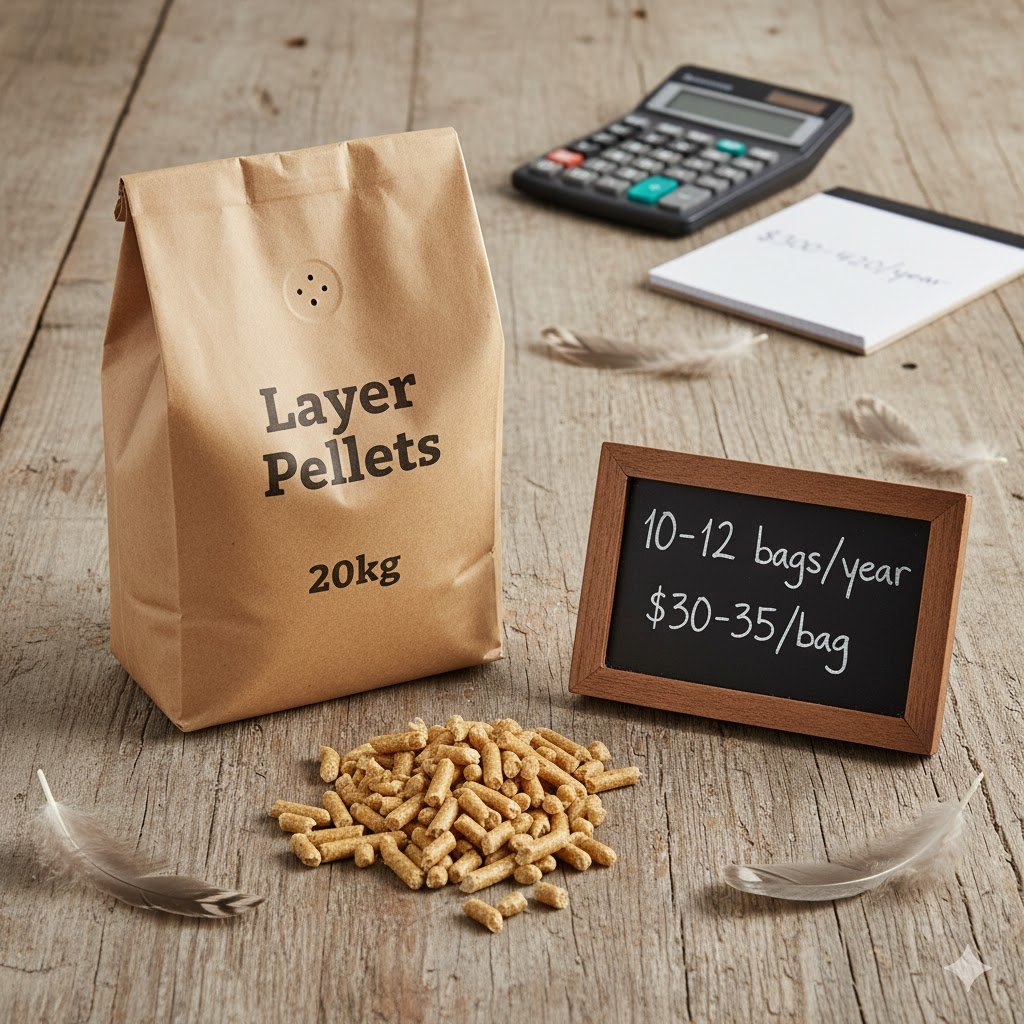
This is the budget that matters most. Here are the annual costs for a flock of 4 hens.
| Item | Annual Cost (AUD) | Details |
|---|---|---|
| Layer Feed | $300 – $420 | Approx 10-12 bags (20kg) at $30-$35/bag. |
| Bedding | $25 – $50 | Using deep-litter method. $25 for 1-2 bales of straw/hemp. |
| Healthcare | $50 – $100 | Wormer, lice/mite powder, supplements. |
| Grit & Oyster Shell | $50 | Essential for digestion and strong eggshells. |
| Total Annual Cost | $425 – $620 | |
| Total Monthly Cost | **$35 – $52** |
How to Save on Bedding Costs

Your bedding cost for 4 hens should be low. The $25-$50 range is based on using the “deep litter method.” This is where you start with a thick 15cm layer of bedding (hemp or pine shavings) and just turn it over with a garden fork each week, adding a fresh thin layer on top. You only do a full clean-out once or twice a year. It saves a huge amount of money and time, and it composts in place, so it doesn’t smell.
Note: This $25-$50 annual cost is significantly lower than the $12-$15/month (or ~$144+/year) you might spend if you do a full clean-out every single week. The deep-litter method requires far less new bedding, saving you money and time.
If you do a full clean-out every single week, your bedding costs will be much higher, closer to $200/year.
How Much Feed Do Chickens Eat?
A laying hen (like an ISA Brown) eats about 100-120 grams of layer pellets per day. This varies by breed size and season (they eat more in winter). For a complete guide to feeding backyard chickens, check out our detailed article.
- 4 hens x 120g/day = 480g/day
- 480g/day x 365 days = 175kg of feed per year
- A 20kg bag of feed costs $30-$35.
- 175kg / 20kg = ~9 bags of feed per year. (My estimate of 10-12 bags gives you a buffer).
Money-Saving Tips (That Actually Work)
- Ferment Your Feed: This is my #1 tip. Soak your pellets in water for 2-3 days. It sounds weird, but it unlocks nutrients, and the chickens eat 20-30% less. It’s a massive cost saver.
- Grow Fodder: Sprout wheat or barley seeds in a tray for a week. It turns $2 of seed into 10kg of fresh, green feed they love.
- Pest-Proof Feeders: A Dine a Chook or treadle feeder is expensive upfront ($90+) but pays for itself in 6 months. It stops rats, pigeons, and sparrows from stealing your feed. My first-year feed bill dropped by 30% after I got one.
Hidden Ongoing Costs
- Emergency Vet Bills: An avian vet is expensive. A standard consult is $100+, plus medicine. You should have a $200 emergency fund set aside. You can lower this risk if you learn how to perform a health check at home regularly.
- Flock Insurance: Yes, you can insure your flock, but it’s very rare for backyard keepers. It’s generally not worth the cost.
- Replacements: A hen lays well for 2-3 years. After that, her production drops. You’ll need to budget $35-$40 every few years to add a new, young layer to the flock.
Following best practices, like those in the RSPCA’s comprehensive chicken care guide, will keep your hens healthy and productive for longer.
Do Chickens Actually Save You Money? The Real ROI
Okay, let’s run the new numbers. Do backyard chooks save an Aussie family money? (Or for a deeper dive, read our detailed ROI analysis).
Let’s assume your ongoing costs are $425/year (the low end) and the average mid-2024 supermarket price for free-range eggs was $7.13/dozen. (Note: prices have risen since then, making your savings even greater).
Scenario 1: Your family buys 1 dozen eggs/week
- Supermarket cost: $7.13 x 52 = **$370.76 per year**
- Your chicken costs: ~$425 per year
- Verdict: You lose about $55 per year. BUT, your 4 hens produce 2 dozen eggs/week. You have a surplus dozen to give away or sell.
- Payback on Setup: You never “break even” on cash alone, but you get far superior eggs for a similar price.
Scenario 2: Your family buys 2 dozen eggs/week
- Supermarket cost: $14.26 x 52 = **$741.52 per year**
- Your chicken costs: ~$425 per year
- Verdict: You SAVE $316.52 per year!
- Payback on Setup: Your annual savings of $316 will pay off your **$544 budget setup** in 1.7 years. After that, you’re in the green.
The non-financial benefits are the real bonus:
- Egg Quality: The flavour and colour of a fresh backyard egg are unbeatable.
- Fertiliser: Chicken manure is “black gold” for your garden.
- Pest Control: They’ll eat all the bugs and weeds in your garden beds (just protect your veggies!).
- Education: They are fantastic, funny pets for kids.
How to Start a Small Poultry Farm in Australia
What if you want to go bigger?
- Backyard: <50 birds
- Small Commercial: 2,000 – 10,000 birds
- Startup Cost: A small commercial farm is a massive leap. You’re looking at $76,450 to $1.53 million for shedding, biosecurity, and equipment. This article focuses purely on the backyard scale. Going commercial is a whole different business.
Biosecurity, Health & First-Aid Kit
Your Biosecurity Duty (Post-Avian Flu)
After the 2024 Victorian avian flu outbreak, biosecurity is no longer optional. It’s your responsibility.
- Stop Wild Birds: Your #1 job. Cover your run and secure your feed. Wild birds, especially ducks and waterfowl, are the main carriers.
- Limit Visitors: Don’t let friends who also have chickens into your coop area.
- Clean Shoes: Have a pair of “coop boots” you only wear in the chicken area.
- Quarantine: New hens must be kept separate for 30 days. For more info, check the Agriculture Victoria or your state’s DPI website.
Your Essential First-Aid Kit (~$50-70)
Buy these before you need them. For a full list of what to look for and why, check out RSPCA Australia’s backyard chicken care guidelines or our complete chicken first-aid kit guide.
- Wormer: (e.g., Avitrol Plus) – $20
- Lice/Mite Powder: (e.g., Pestene) – $15
- Electrolytes: (e.g., Vetsense) – $15 (For heat stress or a sick bird)
- Antiseptic Spray: (e.g., Betadine) – $10
- Gloves & Saline Syringes – $10
Article Disclaimers
Price & Availability Disclaimer: Prices and availability vary by location and season. This guide provides estimates based on 2024-2025 Australian market research and personal experience. Always check current local pricing before buying.
Financial Advice Disclaimer: This article provides general cost estimates for educational purposes only. It is not financial advice. Your individual costs will vary based on your location, choices, and circumstances.
Key Takeaways
- Initial Cost: Expect to spend $540 – $1,100 for a good, safe setup for 4 hens.
- Ongoing Cost: Budget $35 – $52 per month for all feed, bedding, and healthcare.
- Best Value for Beginners: Buy 4 point-of-lay hens (like ISA Browns) and a mid-range, predator-proof coop.
- Biggest Savings: Get a pest-proof feeder and use the deep-litter bedding method.
- The Verdict: You will save significant money (over $300/year) if your family eats 2 or more dozen eggs per week.
Conclusion: So, How Much Does It Cost?
So, how much does it cost to start with chickens in Australia? You can get started on a bare-bones (but safe!) budget for as little as $544 for your full setup and four hens. A more realistic, longer-lasting average setup will be closer to $800 – $1,100.
From there, you can expect to spend about **$425 – $620 per year** (or $35-$52 a month) on feed, bedding, and basic healthcare.
You’ll break even on your costs within 1.7 – 2.5 years (if you eat 2+ dozen eggs a week), but you’ll be “in profit” on egg quality, garden fertiliser, and pure enjoyment from the very first day.
After three years, I can honestly say the costs are minimal for the reward. The “real value” isn’t just in the money I save—it’s in the food security, the unbeatable quality of the eggs, and the fun of watching them potter around the garden.
Frequently Asked Questions (FAQ) on How Much Does It Cost to Start with Chickens in Australia
Are chickens expensive to keep in Australia?
Not really. After the initial setup cost (around $500-$1,100), they cost about $35-$52 per month for a flock of 4-6. This is less than most people spend on dog or cat food, and chickens give you breakfast!
How much does it cost to feed one chicken per month?
It costs about $7-$9 per month to feed one chicken on good quality layer pellets. You can lower this cost by fermenting feed, growing fodder, and letting them free-range for bugs.
What’s cheaper: buying eggs or keeping chickens?
If your family eats 2 or more dozen eggs per week, it is significantly cheaper to keep your own chickens. Your annual savings can be over $300. If you only eat 1 dozen, the cost is about the same, but your egg quality will be far better.
Do I need council permission for backyard chickens?
Maybe. You must check your local council’s website. Most councils allow 5-10 hens but ban roosters in urban areas. Some have rules on coop placement.
How long do backyard chickens live?
A backyard hen can live for 5-8 years. However, their peak egg-laying is only for the first 2-3 years.
When do chickens start laying eggs?
Point-of-lay hens start laying from 18-22 weeks old. Day-old chicks won’t lay for at least 5-6 months.
Can I make money selling eggs from my backyard chickens?
It’s hard to make a profit, but you can easily cover your feed costs. A flock of 4-6 hens will give you 1-2 dozen surplus eggs per week. Selling these to neighbours for $7-$9 a dozen could cover your entire $25-$35/month feed bill. Just check your local rules on selling eggs.

Oladepo Babatunde is the founder of ChickenStarter.com. He is a backyard chicken keeper and educator who specializes in helping beginners raise healthy flocks, particularly in warm climates. His expertise comes from years of hands-on experience building coops, treating common chicken ailments, and solving flock management issues. His own happy hens are a testament to his methods, laying 25-30 eggs weekly.
